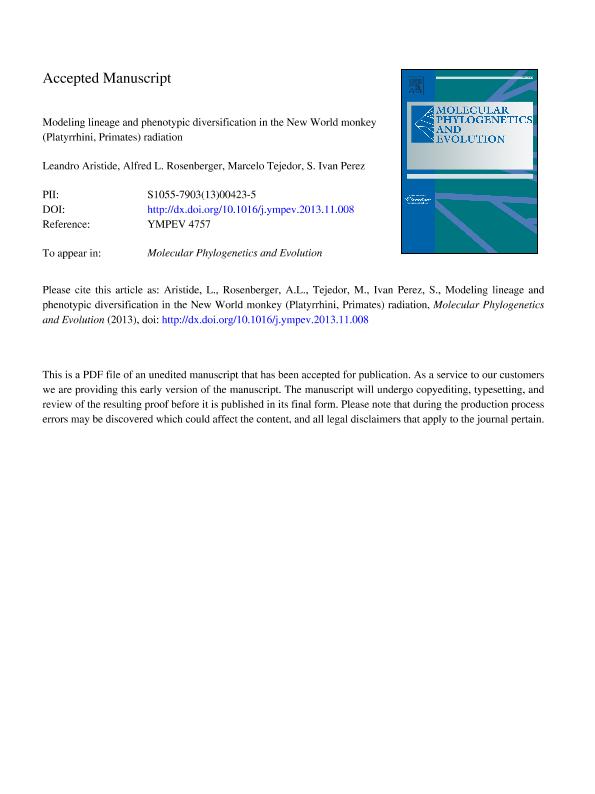Mostrar el registro sencillo del ítem
dc.contributor.author
Arístide, Leandro

dc.contributor.author
Rosenberger, Alfred L.
dc.contributor.author
Tejedor, Marcelo Fabian

dc.contributor.author
Perez, Sergio Ivan

dc.date.available
2016-09-01T21:43:19Z
dc.date.issued
2013-11
dc.identifier.citation
Arístide, Leandro; Rosenberger, Alfred L.; Tejedor, Marcelo Fabian; Perez, Sergio Ivan; Modeling lineage and phenotypic diversification in the New World monkey (Platyrrhini, Primates) radiation; Elsevier; Molecular Phylogenetics and Evolution; 82; Part B; 11-2013; 375–385
dc.identifier.issn
1055-7903
dc.identifier.uri
http://hdl.handle.net/11336/7402
dc.description.abstract
Adaptive radiations that have taken place in the distant past can now be more thoroughly studied with the availability of large molecular phylogenies and comparative data drawn from extant and fossil species. Platyrrhines are a good example of a major mammalian evolutionary radiation confined to a single continent, involving a relatively large temporal scale and documented by a relatively small but informative fossil record. Here, we present comparative evidence using data on extant and fossil species to explore alternative evolutionary models in an effort to better understand the process of platyrrhine lineage and phenotypic diversification. Specifically, we compare the likelihood of null models of lineage and phenotypic diversification versus various models of adaptive evolution. Moreover, we statistically explore the main ecological dimension behind the platyrrhine diversification. Contrary to the previous proposals, our study did not find evidence of a rapid lineage accumulation in the phylogenetic tree of extant platyrrhine species. However, the fossil-based diversity curve seems to show a slowdown in diversification rates toward present times. This also suggests an early high rate of extinction among lineages within crown Platyrrhini. Finally, our analyses support the hypothesis that the platyrrhine phenotypic diversification appears to be characterized by an early and profound differentiation in body size related to a multidimensional niche model, followed by little subsequent change (i.e., stasis).
dc.format
application/pdf
dc.language.iso
eng
dc.publisher
Elsevier

dc.rights
info:eu-repo/semantics/openAccess
dc.rights.uri
https://creativecommons.org/licenses/by-nc-nd/2.5/ar/
dc.subject
Body Size
dc.subject
Adaptive Radiation
dc.subject
Fossil Record
dc.subject
Niche-Filling
dc.subject.classification
Biología

dc.subject.classification
Ciencias Biológicas

dc.subject.classification
CIENCIAS NATURALES Y EXACTAS

dc.title
Modeling lineage and phenotypic diversification in the New World monkey (Platyrrhini, Primates) radiation
dc.type
info:eu-repo/semantics/article
dc.type
info:ar-repo/semantics/artículo
dc.type
info:eu-repo/semantics/publishedVersion
dc.date.updated
2016-04-28T14:52:46Z
dc.journal.volume
82
dc.journal.number
Part B
dc.journal.pagination
375–385
dc.journal.pais
Países Bajos

dc.journal.ciudad
Amsterdam
dc.description.fil
Fil: Arístide, Leandro. Universidad Nacional de La Plata. Facultad de Ciencias Naturales y Museo; Argentina
dc.description.fil
Fil: Rosenberger, Alfred L.. City University Of New York; Estados Unidos
dc.description.fil
Fil: Tejedor, Marcelo Fabian. Consejo Nacional de Investigaciones Científicas y Técnicas. Centro Nacional Patagónico; Argentina
dc.description.fil
Fil: Perez, Sergio Ivan. Universidad Nacional de La Plata. Facultad de Ciencias Naturales y Museo; Argentina
dc.journal.title
Molecular Phylogenetics and Evolution

dc.relation.alternativeid
info:eu-repo/semantics/altIdentifier/url/http://www.sciencedirect.com/science/article/pii/S1055790313004235
dc.relation.alternativeid
info:eu-repo/semantics/altIdentifier/doi/http://dx.doi.org/10.1016/j.ympev.2013.11.008
Archivos asociados
